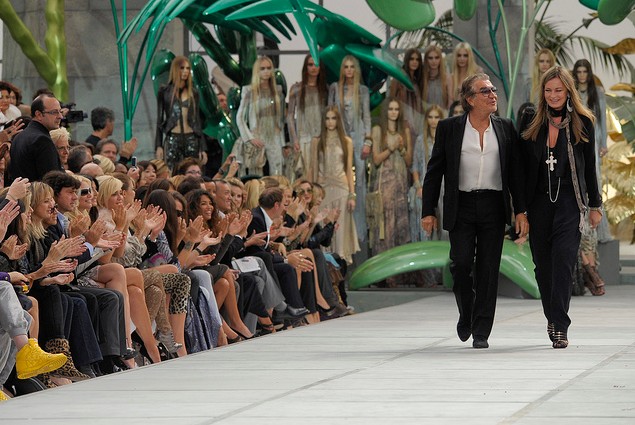
Our analysis of the week’s luxury news headlines
Far Out Opportunities

Virgin Galactic’s SpaceShipTwo (SS2), the center fuselage, which is attached to the winged aircraft dubbed White Knight Two (WK2) used to launch it into suborbital space
Apart from the many ‘feel-good’ stories which the timing of fashion week has prompted news outlets to explore (see these two by Reuters and Bloomberg for a taste), there are also telling but less tangible signs abound that the luxury market is springing back into step. For one, firms catering to UHNWIs in the top tier of the market have been more willing to publicise the types of exceptionally expensive unique experiences they’re about to offer clients.
British billionaire tycoon, Sir Richard Branson, certainly hasn’t been mincing his words when it comes to the imminent launch of commercial space travel through his venture Virgin Galactic. The USA Today reported on his announcement that the more than 340 people who have reserved seats aboard his suborbital craft for $200,000 apiece will begin flying in 18 months.
“ Celebrity chefs may even cook the guests’ meals before they are sent into space. ”
There has been a lot of entrepreneurial drive behind developing complementary services for the elusive space tourism market, the most obvious being hotels. The BBC gave details on the space hotel which Russian venture Orbital Technologies says it could launch into orbit by 2016, with much more comfortable hospitality than is available to scientists at the International Space Station’s facilities. Apparently, the firm is even considering going to the trouble of employing celebrity chefs to cook the guests’ meals before they are sent into space. With such little show of restraint, one might expect at least some of the so-called ‘luxury guilt’ to be seeping through the pages of populist tabloid papers like The Daily Mail when it spun a story around the same topic. But its authors kept a firm lid over any latent desire to bash the super rich.
And it wasn’t too long ago that elements in the mass media would have felt obliged to verbally skewer the Russian billionaire Roman Abramovich for building a £20 million private nightclub under the Chelsea football stadium in London that he owns. But the tone of the piece in the Evening Standard was, all things considered, rather gracious as it described the club’s four metre high waterfalls and how Abromovich was also likely to use it for extravagant parties featuring exclusive concerts by favourite musicians like Amy Winehouse and Gwen Stefani to entertain friends of his and his girlfriend Dasha Zhukova. The media, it seems, has indeed turned the proverbial page on the luxury guilt perspective – for now, at least.
Milan: Innovation Off the Runways

Roberto Cavalli spring/summer 2011 show finale
Now that Paris is in full swing, the shimmering dust from the Milan runways has had time to well and truly settle. Only this season, there was less shimmer and less shimmy being proposed by the protagonists of Italian luxury fashion than in the past few post-recessionary seasons. One needed only to catch a glimpse of the latest Cavalli, Dolce & Gabbana and Versace shows to appreciate just how muffled and muted (relatively speaking, of course) the high-octane segment of luxury has become. No surprise that the stand-out collections of the week then seemed to be those which followed the prevailing mood set by the minimalist, discreet giants who focus on lavish materials and decorative details like Giorgio Armani, Valentino and Bottega Veneta.
Offering a fresh spin on these masters of la bella figura were Agnona (Ermenegildo Zegna’s women’s brand) and Brioni (now designed by long-time insider favourite Alessandro Dell’Acqua). Both punched well above their weight in terms of positive press feedback for being the relatively under-the-radar womenswear brands that they are. Elsewhere, most of the critics summed up the Italian season as one devoted to an optimistic aesthetic of colour and joy (Wallpaper, for instance, decided that it was because “everyone seems to be channeling Marni”).
The Guardian, however, picked up on a broader issue which has been on many fashion insiders’ minds: “Milan, once the powerhouse of international fashion and the spiritual home of the superbrand, has seen its influence dwindle in the past five years.” If, as we posited last week, London Fashion Week appeared to finally be proving its relevance to luxury again and fending off its longstanding identity crisis, then Milan gave the impression to many observers that it might be heading toward a predicament of its own. There is only so long that Italian fashion can thrive if it continues to be characterised, as it inevitably is – and was once again this season by Reuters, as being an industry that merely “shines in wearable luxury”.
“ Prada’s statement will force the Italian luxury industry to reflect on its reliance on perceived provenance ”

Prada’s new open and honest country of origin labels
Apart from the perennially directional designs of Prada and Jil Sander and the lavish minimalism hitherto described, many other Italian luxury fashion brands have been overly dependent upon the perceived value of the ‘Made in Italy’ trademark and their knack for churning out very on-trend wardrobe staples.
Perhaps this explains why the really big luxury stories from Milan were percolating off the runways. With Suzy Menkes breaking the news in the IHT that Miuccia Prada has flaunted convention and took a highly controversial, unilateral and groundbreaking decision to sew country of origin labels into the brand’s products, it now means that Prada’s powerful ‘made in Peru’, ‘made in India’ and ‘made in Japan’ statement will force the entire luxury industry to reflect on its reliance on associating quality with perceived provenance. Nowhere will this be felt more than in the boardrooms of Italy. The designer herself dubbed it, “taking away hypocrisy.”
But ethics and transparency were not the only game-changing 21st century forces which are beginning to turn Italian luxury brands into unlikely innovators off the runway. If the suggestions made by Businessweek are accurate, then Roberto Cavalli may be one of the first big names to follow in the footsteps of Hugo Boss to consider increasing the speed with which the firm refreshes inventory. Unable to keep up the pace or compete in price with fast fashion brands, many of Milan’s ‘wearable’ luxury brands have become direct competitors of COS, TopShop and Zara because these retailers cut into the profits of the luxury brands’ once almighty diffusion lines. If luxury apparel does become more seasonless, it could cause an entire rethink of the classic twice yearly fashion show cycle, especially as designers are more inclined to consider new media like video nowadays anyway. Could this be the beginning of a slow but stead march toward revolution of the runway?
West meets East on the M&A; Frontline

EIH’s Trident Hotel in Bhubaneswar
As deals like Gianfranco Ferré’s probable sale to a private equity consortium led by Prodos Capital Management and a possible alliance between Saab and BMW brokered by Saab’s new owners Spyker Cars grip M&A; news-watchers in the West (as reported by the New York Times here and here), some very interesting transactions are taking place further East which no luxury industry pundit should ignore.
ITC, a diverse multi-sector Indian conglomerate that operates a group of 5-star hotels under its luxury collection banner ITC WelcomGroup, will merge with another giant in the local luxury hospitality industry, EIH, which controls the Oberoi and Trident chains. The competitive advantage such a merger could give the new group over incoming international hotel brands is something to certainly ponder. Reuters cited the original report in India’s Financial Express, and concluded that “the plan would result in a three-way venture between the two firms and India’s top listed conglomerate, Reliance Industries, which in August bought a 14.1 percent stake in EIH for $217.5 million.”
“ Some very interesting M&A; activity is happening further East which no luxury industry pundit should ignore. ”
Meanwhile, Morgan Stanley’s Asia market private equity arm, MSPEA Luxury Holding, has paid $42m for a 10.6 per cent stake in Sparkle Roll, a Chinese partner/distributor of ultra luxury brands like Bentley, Rolls Royce, Lamborghini, Boucheron and Duclot. The Financial Times blogger reporting on the acquisition noted that Sparkle Roll was a very attractive and unique asset because of its number one position but advised that it needed wider distribution and deeper penetration across the country:
“High-end property developer, FPG Land, is a distant second in terms of tapping China’s rich list… In operating margins…its margin [is] almost double that of other mainland Chinese distributorships like Zhongsheng and Dah Chong Hong. Sparkle Roll’s watch-making business has margins of 40 per cent…. However, while strong in Beijing, Sparkle Roll lacks a nationwide network. As affluence spreads across mainland China, can Sparkle Roll follow the trend?”










